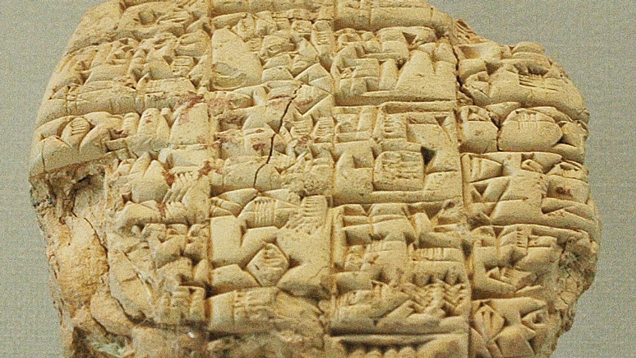Calculus origins 1500 years older than originally believed
 CREDIT: LOUVRE
CREDIT: LOUVRECuneiform tablets like this were Babylonians equivalent of paper. Babylonians were actually the first civilization to use calculus.
The world is shaken up by Britain's new “okay” on human embryo testing, while the roots of calculus are revealed to be much older than earlier thought in this week's romp through the scientific world.
Ancient civilization created pre-calculus 1500 years earlier than previously thought
A German astrophysicist researching Babylonian texts relating to the orbit of Jupiter has found that the ancient civilization was using a preform of calculus to more accurately track the gas giants' path through the night sky.
The texts were written in cuneiform, an advanced written language used between 3500 BCE and 100 CE that relied on a triangular stylus impressing between 600 and 1,000 different symbols into soft clay pucks. The clay would harden into small handheld tablets, which there are now hundreds of thousands of them still preserved.
Mathieu Ossendrijver translated four tablets from between 350 and 50 BCE and found that the ancient astronomers were using motion-velocity graphs to track the movement of the solar system's largest planet.
A basic understanding about calculus is that it's used to calculate the area under a curve. The area under a straight line is easy, but with a curve, there ends up being an approximation. The closer the approximation can get, the more accurate the value.
An early tool in calculus was called the trapezoid rule, where the curve is broken into multiple columns, or trapezoids, between a set number of points on the curve, with the area of each trapezoid approximated, and then added together.
The system was originally thought to have originated in 14th century Europe, but Ossendrijver's research has shown that ancient humans were thinking with a greater degree of abstract and geometric mathematics than previously thought.
It's already known that the Babylonian civilization, which at its oldest dates back almost 5,000 years, excelled at mathematics and astronomy. They are credited with the creation of the astronomical and astrological zodiac and the concept of a 360-degree circle.
With the newly translated tablets though, history books now have quite a bit of catching up to do.
Genetic editing of human embryos ‘okayed' in Britain
The British Human Fertilisation and Embryology Authority (HFEA) has granted the “okay” for a team of scientists at the Francis Crick Institute in London, England, to begin genetic editing of human embryos, a first in the country, and in a world precedent becoming the first regulatory body to approve the experiments.
Last year, researchers in China used the now-famous clustered regularly- interspaced short palindromic repeats (CRISPR) editing gene to perform modification on non-viable embryos. They corrected a congenital eye deformity, but with biotech regulation in world's most populous country being murky, it was unknown if the project was approved by any oversight committee.
Multiple anti-gene modification and religious groups worried about the possibility of “designer humans” have begun to raise alarm over the move, but the HFEA has already given the public assurances that it will be illegal to implant the genetically altered embryos back into a female.
The project, headed by developmental biologist Kathy Niakan, is looking into which genes are specifically responsible for maintaining a healthy embryo, and the link between malfunctioning genes and miscarriages.
The research hopes to more fully understand what genes are working at specific stages of embryo growth, and how to increase in vitro fertilization (IVF) success rates.
The embryos will be studied for seven days, reaching around 200 to 300 cells large and called a blastocyst. The embryos will then be destroyed after the study ensuring no ethical breaches.
The embryos are sourced from patients who voluntarily gave up unneeded embryos after undergoing IVF, a process where eggs are removed from the ovaries, and then manually fertilized in a laboratory, and finally inserted into the lining of the uterus.
IVF is used for couples with infertility issues who still want to conceive, and is relatively common, having first been successfully used to produce a child in 1978.
Next week we'll look at an interstellar gas cloud headed towards the Milky Way Galaxy, and give a shout out to NASA's Opportunity probe, trudging along the Martian landscape for the past 12 years.














